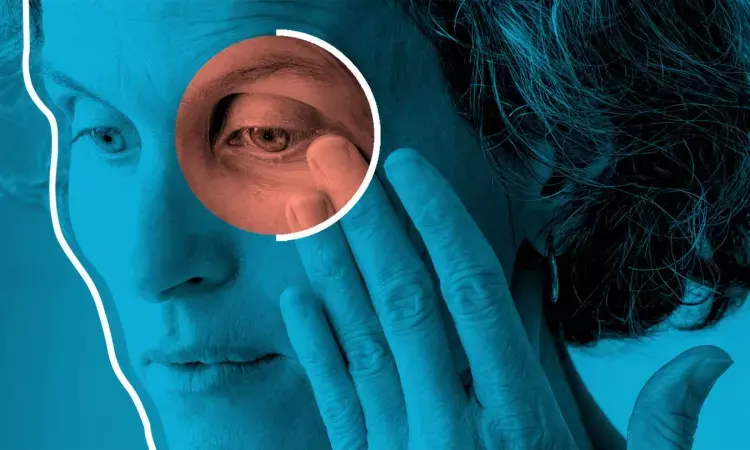- Home
- Medical news & Guidelines
- Anesthesiology
- Cardiology and CTVS
- Critical Care
- Dentistry
- Dermatology
- Diabetes and Endocrinology
- ENT
- Gastroenterology
- Medicine
- Nephrology
- Neurology
- Obstretics-Gynaecology
- Oncology
- Ophthalmology
- Orthopaedics
- Pediatrics-Neonatology
- Psychiatry
- Pulmonology
- Radiology
- Surgery
- Urology
- Laboratory Medicine
- Diet
- Nursing
- Paramedical
- Physiotherapy
- Health news
- Fact Check
- Bone Health Fact Check
- Brain Health Fact Check
- Cancer Related Fact Check
- Child Care Fact Check
- Dental and oral health fact check
- Diabetes and metabolic health fact check
- Diet and Nutrition Fact Check
- Eye and ENT Care Fact Check
- Fitness fact check
- Gut health fact check
- Heart health fact check
- Kidney health fact check
- Medical education fact check
- Men's health fact check
- Respiratory fact check
- Skin and hair care fact check
- Vaccine and Immunization fact check
- Women's health fact check
- AYUSH
- State News
- Andaman and Nicobar Islands
- Andhra Pradesh
- Arunachal Pradesh
- Assam
- Bihar
- Chandigarh
- Chattisgarh
- Dadra and Nagar Haveli
- Daman and Diu
- Delhi
- Goa
- Gujarat
- Haryana
- Himachal Pradesh
- Jammu & Kashmir
- Jharkhand
- Karnataka
- Kerala
- Ladakh
- Lakshadweep
- Madhya Pradesh
- Maharashtra
- Manipur
- Meghalaya
- Mizoram
- Nagaland
- Odisha
- Puducherry
- Punjab
- Rajasthan
- Sikkim
- Tamil Nadu
- Telangana
- Tripura
- Uttar Pradesh
- Uttrakhand
- West Bengal
- Medical Education
- Industry
Teprotumumab effective in Thyroid Eye Disease but may take longer time to act in some: Study

Teprotumumab Early Response Is Not Required for Benefit for Thyroid Eye Disease, suggests a study published in the Eye (Lond).
In recent trials, 50% of patients treated with teprotumumab for thyroid eye disease had significant improvements in proptosis at 6 weeks. However, a small subgroup of patients did not have a significant response by week 12.
A group of researchers from U.S.A conducted a study to examine the outcomes at week 24 in patients from both trials who had little or no proptosis response at week 12.
In this post hoc analysis, data from teprotumumab-treated patients in the placebo-controlled randomized phases 2 and 3 trials were reviewed.
Patients treated with teprotumumab or placebo with a ≤2 mm reduction from baseline in proptosis at week 12 and completed assessments at both the weeks 12 and 24 visits were included. The main outcome measures were a change in proptosis, clinical activity score (CAS) and diplopia in response to teprotumumab therapy at baseline and weeks 6, 12, 18, and 24.
The results of the study are as follows:
· From the phases 2 and 3 studies, 24 patients from the treated and placebo groups were included for analysis (48 total).
· In the teprotumumab group, of the 24 who had no improvement in proptosis (≥2 mm from baseline) at 12 weeks, 15 (63%) demonstrated a clinically significant improvement at week 24.
· No patients from the 24 placebo patients had a clinically significant improvement in proptosis at 12 weeks, and 24 weeks.
· At week 12, 22 patients (92%) in the teprotumumab group had a significant reduction in the CAS (≥2 points) and at 24 weeks all patients achieved this reduction.
· At week 12, 11 (46%) patients from the placebo group had a significant improvement, while 10 (42%) had a significant improvement at 24 weeks. 22 of the 24 patients (92%) in the teprotumumab group had a diplopia grade > 0 at baseline.
· At week 12, 12 of the 22 (55%) had improvement in diplopia ≥ 1 grade. By week 24, 16 patients (73%) had an improvement in diplopia ≥ 1 grade. In the placebo group, 15 (63%) had significant diplopia.
· At week 12, 3 (20%) from this group had improvement in diplopia ≥ 1 grade, while at 24 weeks this number rose to 4 (27%).
Thus, the researchers concluded that there is variability in the time taken to manifest a clinically significant response to teprotumumab, some patients my need a longer time to respond.
Reference:
Teprotumumab for thyroid eye disease: early response is not required for benefit by Ugradar S et. al published in the Eye (Lond)
DOI: 10.1038/s41433-021-01539-5
Dr. Shravani Dali has completed her BDS from Pravara institute of medical sciences, loni. Following which she extensively worked in the healthcare sector for 2+ years. She has been actively involved in writing blogs in field of health and wellness. Currently she is pursuing her Masters of public health-health administration from Tata institute of social sciences. She can be contacted at editorial@medicaldialogues.in.
Dr Kamal Kant Kohli-MBBS, DTCD- a chest specialist with more than 30 years of practice and a flair for writing clinical articles, Dr Kamal Kant Kohli joined Medical Dialogues as a Chief Editor of Medical News. Besides writing articles, as an editor, he proofreads and verifies all the medical content published on Medical Dialogues including those coming from journals, studies,medical conferences,guidelines etc. Email: drkohli@medicaldialogues.in. Contact no. 011-43720751


